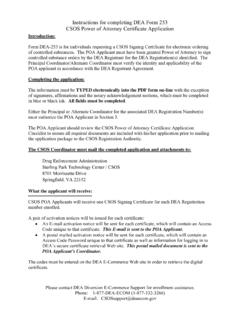Transcription of Overview of Public Key Infrastructure (PKI)
1 PKI Overview PEC Solutions, Inc. 1 12/4/2007 Overview of Public Key Infrastructure (PKI) 1 Introduction The section provides an Overview of Public Key Infrastructure . It is presented at this point in the concept of operations as an aid to the reader because many of the terms and concepts of PKI will be used in subsequent sections. 2 Benefits Electronic ordering systems for controlled substances and controlled substance prescription systems have the capability to (1) reduce the amount of paper, (2) speed transaction times, (3) lower costs per transactions, (4) improve accuracy of entries, (5) improve data archive and retrieval, and (6) improve overall system effectiveness and efficiency.
2 While these systems can provide the above benefits, they do not alone provide a sufficiently secure Infrastructure to permit their employment in every environment. 3 Security PKI technology adds the following security services to an electronic ordering system: Confidentiality - only authorized persons have access to data. Authentication - establishes who is sending/receiving data. Integrity - the data has not been altered in transmission. Non-repudiation - parties to a transaction cannot convincingly deny having participated in the transaction. 4 Fundamentals of Public Key Infrastructure The sections below introduce the key concepts involved in cryptography and PKI. The reader already familiar with this information may skip this section and proceed to Section 4.
3 Terms and Definitions Key aka cryptographic key, an input parameter that varies the transformation performed by a cryptographic algorithm. Secret key - a key used in a symmetric cryptographic transformation where the key is protected from being known by any system entity except those who are intended to know it. PKI Overview PEC Solutions, Inc. 2 12/4/2007 Private key the non-publicly disclosable component of a pair of cryptographic keys used for asymmetric cryptography. Public key the publicly disclosable component of a pair of cryptographic keys used for asymmetric cryptography. Encryption cryptographic transformation of data (plaintext) into a form (ciphertext) that conceals the data s original meaning to prevent it from being known or used.
4 Decryption cryptographic transformation of data (ciphertext) that restores encrypted data to its original state (plaintext). Hash algorithm (or hash function) an algorithm that computes a value based on a data object (such as a message or file; usually of variable length; possibly very large), thereby mapping the data object to a smaller data object (the hash result ) which is usually a fixed-size value. Message digest the fixed size result of hashing a message. Secret key (conventional) cryptography a synonym for symmetric cryptography. Symmetric cryptography a branch of cryptography involving algorithms that use the same key for two different steps of the algorithm (such as encryption and decryption).
5 Asymmetric cryptography a modern branch of cryptography in which the algorithms employ a pair of keys (a Public key and a private key) and use a different component of the pair for different steps of the algorithm. Public key cryptography synonym for asymmetric cryptography. Public Key The PK in PKI Cryptography Cryptography deals with the transformation of ordinary text (plaintext) into a coded form (ciphertext) by encryption and the transformation of ciphertext into plaintext by decryption. Historically, before the advent of mechanical or electrical computers, the transformation was performed by hand and included, for example, the procedures of substitution and transposition. Whether performed by hand or by computer, these procedures, or transformations, are mathematical in nature.
6 The transformation procedure is known as the cryptographic algorithm. In a computer environment, the encryption and decryption algorithm uses a cryptographic key to perform these mathematical transformations. The key functions PKI Overview PEC Solutions, Inc. 3 12/4/2007 as an input parameter to vary the transformation of plaintext to ciphertext and vice versa. When the cryptographic system uses a single key for both encryption and decryption, the key is known both as a symmetric and secret key. Exhibit 1 illustrates the symmetric key cryptography process. Exhibit 1. Symmetric Key Process A disadvantage of a symmetric key system is that as cryptographic systems increase in scope and complexity, that is, as the number of participants increase, it becomes increasingly difficult and prohibitively expensive to manage the safe distribution of the secret key or keys.
7 Public Key Cryptography Public key cryptography, known as asymmetric cryptography, is a modern branch of cryptography in which the cryptographic algorithms employ a pair of keys. Public key cryptography is distinct from traditional, symmetric key cryptography in which the same key is used for both encryption and decryption. The two keys are the Public key and the private key, and either can encrypt or decrypt data. A user gives his or her Public key to other users, keeping the private key to him or herself. Data encrypted with a Public key can be decrypted only with the corresponding private key, and vice versa. PKI Overview PEC Solutions, Inc. 4 12/4/2007 The asymmetric key system does not have the disadvantages of a symmetric key system because the Public key is made widely available so that anyone can possess it.
8 In this system only the private key needs to be kept private. Each entity can retrieve another entity s freely available Public key, thus removing key distribution management complexity. Exhibit 2 shows the Public key cryptography s use of the Public and private keys. Exhibit 2. Asymmetric Key Process Hash function processes A cryptographic hash function is a function where it is computationally infeasible to find either (a) a data object (plaintext) that maps to a pre-specified hash result (the one-way property) or (b) two data objects (plaintext A and plaintext B) that map to the same hash result (the collision-free property). Exhibit 3 illustrates the hash process used to generate a fixed size code from any size input message, in this case an arbitrary 160 bit code.
9 PKI Overview PEC Solutions, Inc. 5 12/4/2007 Exhibit 3. An Example of a Hash Function Process Digital Signature A digital signature is a Public key cryptography process in which a signer "signs" a message in such a way that anyone can verify that the message was signed by no one other than himself, and that the message has not been modified since he signed it. The digital signature process results in a bit string that allows a recipient of a message to verify the identity of the signer of the message and the integrity of the message. Any one of several digital signature algorithms can generate the bit string. These algorithms have the generic characteristic that private information is used to make a signature and Public information is used to verify signatures.
10 A private key should be unique to its owner. If the owner of a private key uses it to encrypt a digital document, that encryption may be assumed to have the same meaning as a paper signature. That is to say, it is a mark on the document that only the owner could have made. In many algorithms, the owner does not sign an entire document but rather a digest of a document. A typical implementation of digital signature involves a message-digest, a private key for encrypting the message digest, and a Public -key for decrypting the message digest. The digital signature procedure is as follows: The sender. The software used by the sender computes; using a standard algorithm, a message digest from the message.











